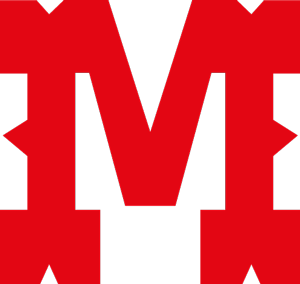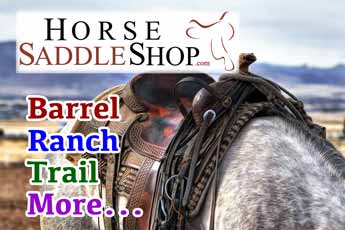How To Tie A Horse Safely
To tie a horse safely means to tie it so that it is unlikely to hurt itself, or anyone or anything nearby.
Below: A horse safely tied to a horse trailer.
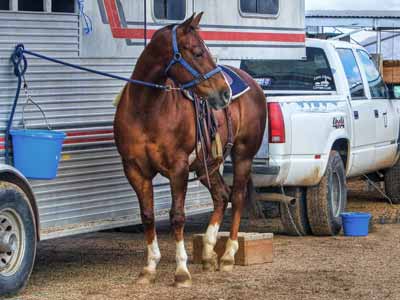
In the article below we have a few tips to help you tie your horse safely.
Note: The information below has general information on how to tie a horse. You can see this page if you are looking for a quick release knot.
Tie To Sturdy Objects
Only tie your horse to objects that it cannot move, pull over, or break.
Remember, a horse is very powerful, and a spooked or frightened horse is even more powerful.
For example, if tying a horse to a fence never tie it to the fence rail. Instead, always tie it to the fence post. Fence rails are broken far more easily than the posts.
By the way, not all fence posts are sturdy enough to tie your horse to. Never tie your horse to a post or anything else that isn't able to withstand several strong pulls from a frightened horse.
Equipment Counts
Tie your horse with a quality lead rope (more on lead ropes below) and a properly fitting halter.
Do not tie your horse with the reins and bridle. They were not designed to tie a horse with.
"Always Tie Short And High"
There's an old adage in the horse industry that says: "Always Tie Short And High."
Short
Tie a horse with enough slack in the lead rope that they can lower their head to approximately the bottom of their chest, but not longer. This will allow them to hang their head at a comfortable, natural level.
Some folks feel like you can allow a tied horse to lower their head to approximately their knees. This is a judgement call that comes with experience and/or knowledge of a particular horse.
However long a horse is tied, there should not be enough slack for the horse to get a leg over the slack in the rope.
High
The object a horse is tied to should be approximately the same height as the horse's back or higher.
Tying a horse too low will allow a horse to get a leg over the rope, or its head stuck underneath the rope. Both of these can result in panic and possibly injury.
Below: A horse safely tied "short and high." Also notice the quality lead rope and properly fitting halter.
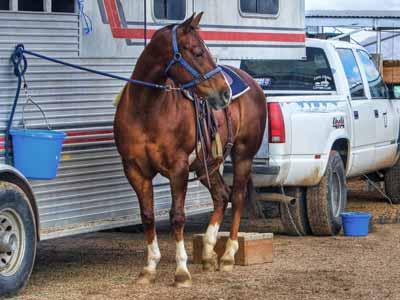
Use A Quick Release Knot
Tie your horse with a quick release knot. A "quick release" knot is a knot that comes untied quickly and easily when the tail of the rope is pulled on.
You can learn how to tie a quick release knot here.
The gray horse in the photo below is tied securely and safely. Notice the safe object he is tied to, the height he is tied at, and like the horse above, he is tied with a quick release knot. Note: We realize the knot can't be seen clearly, but it is a quick release knot.
Below: A gray horse safely tied to a sturdy post.
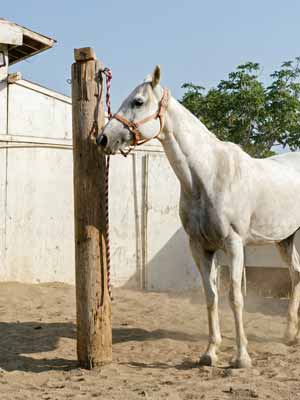
Below: This horse is tied to a sturdy object, and at a height above his back. These are both good things. We can't see the knot he is tied with, however, but can hope it is a quick release knot.
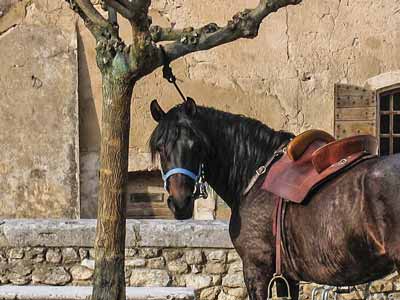
Bad Things To Tie A Horse To
Bad, or downright stupid things, to tie a horse to that we have actually seen people use include:
- Lawn chairs
- T-posts
- Fence rails
- Wire fence
- Car bumpers
- Portable panels
- Empty round bale feeders
- Vehicle mirrors
- Truck tail gates
- Garbage dumpsters
- And others.
All of the items in the above list are not sturdy enough to withstand the power of a horse.
About the garbage dumpster in the above list: At a rodeo, we once saw two people tie their horses to a garbage dumpster. Something spooked the horses, and together they dragged the large, metal dumpster down a row of parked cars.
Neither horse was injured, but of course the bad experience probably affected them for a long time. In addition, the row of parked cars had a great deal of damage.
Below: A horse with its reins looped around the rail of a chain link fence. Even though this horse isn't tied with a knot, the reins are likely to grip the rail tightly if the horse pulls or tries to run. This is liable to result in injury to the horse, nearby people, and/or property damage.
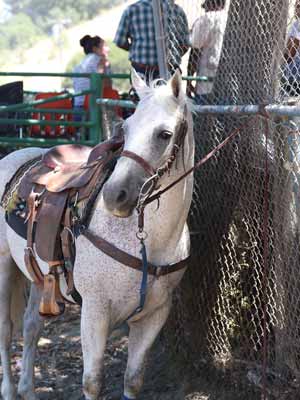
Below: This colt is tied far too low and to an entirely unsuitable object. The halter also fits him poorly, and he seems to be tied solid (not with a quick release knot). Everything about this situation can easily lead to injury.
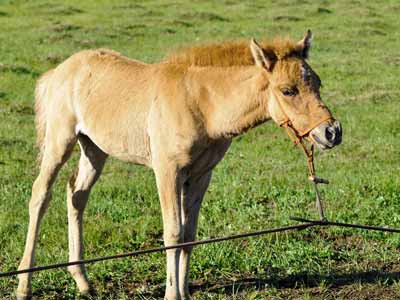
A Few More Import Tips On Tying A Horse
Tie your horse to something that will not poke or hurt its face or eyes if it should jump forward.
Tying a horse excessively long is very dangerous. Not only can they get a leg over the rope, if the rope is long enough they can run a few steps if they spook and jerk themselves down. Sadly, we have seen this happen.
Always use a good quality, properly fitting halter and a lead rope when tying a horse.
Strange horses should always be tied with enough distance between each other that they cannot bite or kick one another.
Horses that know each other and that do not fight can be tied a little closer together, but should always be tied so that they cannot bite each other or the tack the other horse is wearing.
About Lead Ropes
Tie a horse with an appropriate lead rope. Round ropes that don't easily "pull down" under pressure are best. If a rope pulls down under pressure it puts the knot into a bind so that it becomes difficult or impossible to untie, even with a quick release knot.
Round lead ropes made of cotton that are 3/4 of an inch in diameter or larger are considered by many horse people to be the best ropes for tying a horse. That's because this type of lead rope isn't as easily pulled into a bind as other types. In addition, cotton is slower to rope burn a horse than other materials.
Other types of lead ropes may work well, too, as long they don't pull down under pressure.
Flat lead ropes of any material make a very poor rope to tie a horse with as they easily pull down too tight for the knot to be quickly released.
Keep a knife or other suitable tool handy to cut a lead rope if necessary. Pocket knives are excellent safety tools for horse owners and handlers.
How To...
… Care For Your Felt Cowboy Hat
… Care For Your Saddle Pad Or Blanket
… Close A Gate With A Chain Latch
… Estimate Cattle Age By Their Teeth
… Fishtail Braid Your Horse's Tail
… Make A Bridle Rack Out Of Tin Cans
… Make A Collapsible Wood Saddle Rack
… Make A Flag Boot Out Of A Horn
… Make Homemade Hoof Conditioner
… Make Homemade Horse Fly Spray
… Measure A Western Saddle Seat
… Put A Horn Knot On Your Rope
… Put A Speed Burner On A Honda
… Recognize Common Horse Colors
… Recognize Common Horse Face Markings
… Stop A Saddle From Squeaking
… Tell A Boy Cow From A Girl Cow
… Tell A Horse Skull From A Cow Skull
… Tie A Stopper Knot
Tie a stopper knot for the end of a rope, or a metal, rawhide, or plastic honda
… Tie A Stopper Knot For A Honda
Tie a stopper knot for a tied honda
… Understand Leather / Hide Thickness
… Weigh A Horse and Optimize Rider Weight
… Wrap A Saddle Horn With Rubber
You Might Also Like...
